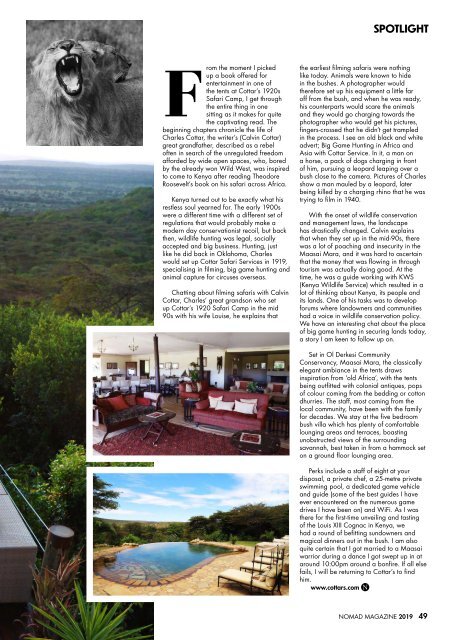You also want an ePaper? Increase the reach of your titles
YUMPU automatically turns print PDFs into web optimized ePapers that Google loves.
SPOTLIGHT<br />
F<br />
rom the moment I picked<br />
up a book offered for<br />
entertainment in one of<br />
the tents at Cottar’s 1920s<br />
Safari Camp, I get through<br />
the entire thing in one<br />
sitting as it makes for quite<br />
the captivating read. The<br />
beginning chapters chronicle the life of<br />
Charles Cottar, the writer’s (Calvin Cottar)<br />
great grandfather, described as a rebel<br />
often in search of the unregulated freedom<br />
afforded by wide open spaces, who, bored<br />
by the already won Wild West, was inspired<br />
to come to Kenya after reading Theodore<br />
Roosevelt’s book on his safari across Africa.<br />
Kenya turned out to be exactly what his<br />
restless soul yearned for. The early 1900s<br />
were a different time with a different set of<br />
regulations that would probably make a<br />
modern day conservationist recoil, but back<br />
then, wildlife hunting was legal, socially<br />
accepted and big business. Hunting, just<br />
like he did back in Oklahoma, Charles<br />
would set up Cottar Safari Services in 1919,<br />
specialising in filming, big game hunting and<br />
animal capture for circuses overseas.<br />
Chatting about filming safaris with Calvin<br />
Cottar, Charles’ great grandson who set<br />
up Cottar’s 1920 Safari Camp in the mid<br />
90s with his wife Louise, he explains that<br />
the earliest filming safaris were nothing<br />
like today. Animals were known to hide<br />
in the bushes. A photographer would<br />
therefore set up his equipment a little far<br />
off from the bush, and when he was ready,<br />
his counterparts would scare the animals<br />
and they would go charging towards the<br />
photographer who would get his pictures,<br />
fingers-crossed that he didn’t get trampled<br />
in the process. I see an old black and white<br />
advert; Big Game Hunting in Africa and<br />
Asia with Cottar Service. In it, a man on<br />
a horse, a pack of dogs charging in front<br />
of him, pursuing a leopard leaping over a<br />
bush close to the camera. Pictures of Charles<br />
show a man mauled by a leopard, later<br />
being killed by a charging rhino that he was<br />
trying to film in 1940.<br />
With the onset of wildlife conservation<br />
and management laws, the landscape<br />
has drastically changed. Calvin explains<br />
that when they set up in the mid-90s, there<br />
was a lot of poaching and insecurity in the<br />
Maasai Mara, and it was hard to ascertain<br />
that the money that was flowing in through<br />
tourism was actually doing good. At the<br />
time, he was a guide working with KWS<br />
(Kenya Wildlife Service) which resulted in a<br />
lot of thinking about Kenya, its people and<br />
its lands. One of his tasks was to develop<br />
forums where landowners and communities<br />
had a voice in wildlife conservation policy.<br />
We have an interesting chat about the place<br />
of big game hunting in securing lands today,<br />
a story I am keen to follow up on.<br />
Set in Ol Derkesi Community<br />
Conservancy, Maasai Mara, the classically<br />
elegant ambiance in the tents draws<br />
inspiration from ‘old Africa’, with the tents<br />
being outfitted with colonial antiques, pops<br />
of colour coming from the bedding or cotton<br />
dhurries. The staff, most coming from the<br />
local community, have been with the family<br />
for decades. We stay at the five bedroom<br />
bush villa which has plenty of comfortable<br />
lounging areas and terraces, boasting<br />
unobstructed views of the surrounding<br />
savannah, best taken in from a hammock set<br />
on a ground floor lounging area.<br />
Perks include a staff of eight at your<br />
disposal, a private chef, a 25-metre private<br />
swimming pool, a dedicated game vehicle<br />
and guide (some of the best guides I have<br />
ever encountered on the numerous game<br />
drives I have been on) and WiFi. As I was<br />
there for the first-time unveiling and tasting<br />
of the Louis XIII Cognac in Kenya, we<br />
had a round of befitting sundowners and<br />
magical dinners out in the bush. I am also<br />
quite certain that I got married to a Maasai<br />
warrior during a dance I got swept up in at<br />
around 10:00pm around a bonfire. If all else<br />
fails, I will be returning to Cottar’s to find<br />
him.<br />
www.cottars.com<br />
NOMAD MAGAZINE 2019 49

















